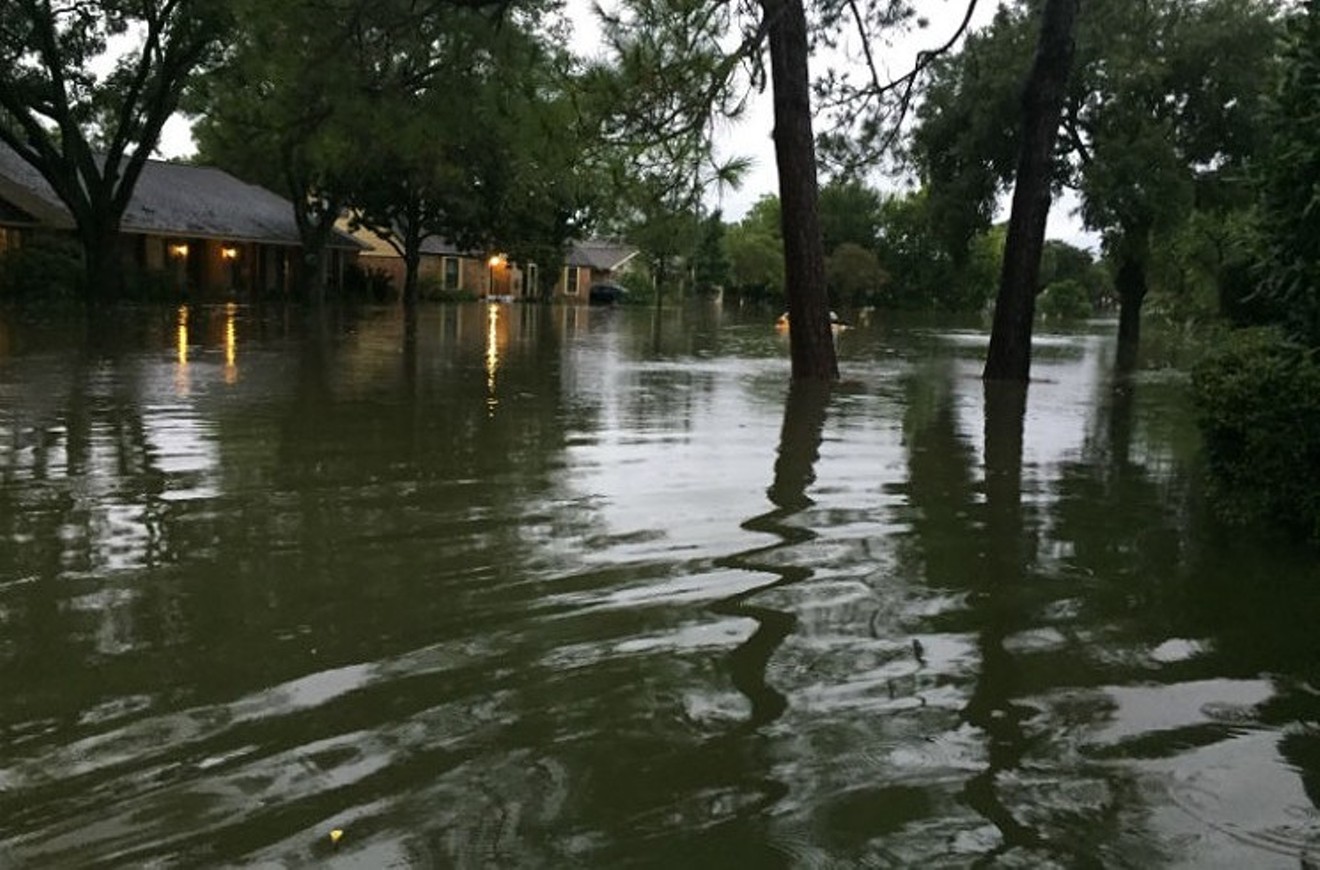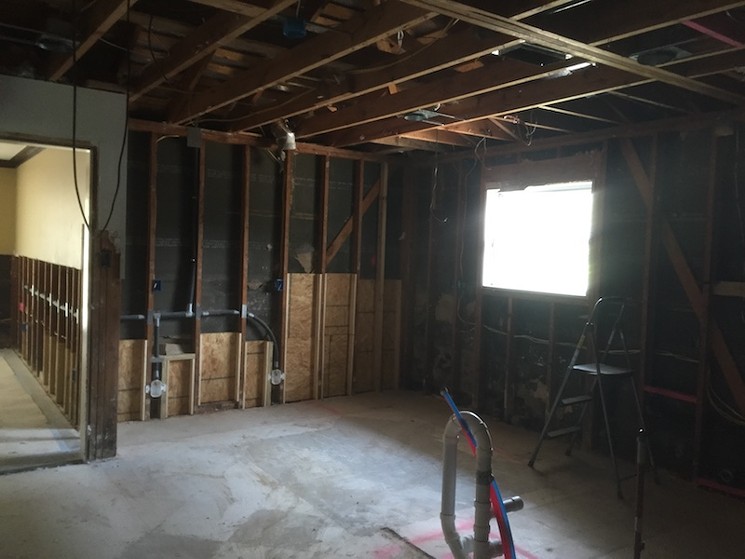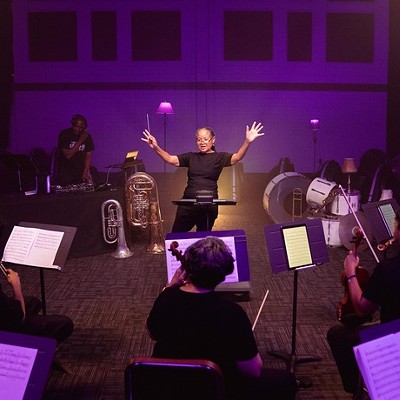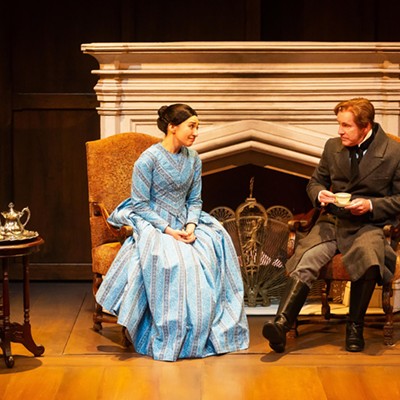Since Harvey I have been living in two places, the way you do when you’re in the midst of reading a book and you have that second landscape tucked in your mind somewhere. One place is Chicago, where I live. We’ve been having a cool summer, a few sprinkles the last couple of days. Someone mentions school starting and I almost say: “But it’s starting late, because of the water.” The other place is my hometown, Houston.
School started here last week. Some students have already walked out, to protest President Trump’s decision on DACA.
ABC-13’s Jeff Ehling was broadcasting from a rescue boat and pointed out my old elementary school, Kolter, which had three feet of water, with a high-water mark two feet higher. The school was named, our teachers told us, for the principal of another school who died in a fire, after everyone else escaped, like a captain going down with the ship.
"Who by fire and who by water"
You, dear readers, have lived through it, the water in biblical proportions, rescues, deaths, homes devastated and spared, heroism and bad judgment. Severely damaged public buildings. The smell and eternal wetness. The knowledge that it will take tens of billions of dollars and many years to recover.
Ehling was in Meyerland, named for George Meyer, who developed inherited land (some of it rice fields) into a subdivision. Vice President Richard Nixon cut the ribbon at the dedication in 1955. Nixon praised one of the model homes as well as an H-bomb shelter.
*********
Meyerland was already hit hard by the Memorial Day flood of 2015 and the Tax Day Flood of 2016. Turf (sodden) of the Jews. In the 1960s and '70s, most of Houston's Jews lived thereabouts, though Meyerland was not majority Jewish. The same with my high school, Bellaire, in the 1970s. Meyerland agitated me and stifled me with its smallness and steadiness, one generation begetting another who stayed within its confines. There was gossip and pecking order and few intellectuals, besides my friend P who read The New Yorker and was in Debate. The friendly girls were popular. I was tongue-tied. You’ve heard this story forever.
And there is comfort, too, in community and continuity. My ballet recital when I was six was held in the downtown Music Hall, where we went for High Holiday services because the old Beth Yeshurun couldn’t handle the crowd, and where we would have our high-school graduation, in our red robes that hid our squirt guns.
There were only six congregations in Houston back then, and one had such a low profile I didn’t know about it. I felt I knew someone from every Jewish family. And sometimes family secrets.
Now there are dozens of synagogues and any number of Jewish neighborhoods.
The city’s Jewish population is 63,700, and 71 percent of Jews live where there was high flooding, an official from the Jewish Federation of Greater Houston told the Jewish Telegraphic Agency recently. ZIP code 77096, Meyerland, contains the largest percentage of Jews within greater Houston, 14 percent, according to a 2016 Federation study. Jews make up less than 1 percent of the greater Houston population, but some 9 percent of Jewish households had some damage from the Memorial Day Flood in 2015.
A 1976 study states that the High Density Area (of Jews) was bounded by Buffalo Speedway, Bellaire Boulevard to Bissonnet Street, South Gessner Road on the west, and West Bellfort on the south. In this area, Jews made up about one-fourth of the overall population. Houston, as you know, is the fourth-largest city in the country. It has the 32nd-largest Jewish community.
The state’s first synagogue, Beth Israel, was founded in 1859 in Houston by 32 young, mostly immigrant men. At least six of the men owned slaves, “though most only owned one as a house servant,” according to the Institute for Southern Jewish Life. Just one. But still an enslaved person. Owned.
Beth Israel was Orthodox, then Reform. When I was growing up, it seemed that everyone was more or less the same kind of Jewish, preparing for a double bar or bat mitzvah, boys bareheaded in school. No one was hippie-Jewish or Hasidic — just Jewish enough to use Hebrew letters to handwrite in code during public school classes. We did not think of ourselves as less-than Jews or faux Jews just because we were not in New York or Chicago or L.A. We were our own norm. We didn’t know that they didn’t imagine that we existed.
“Where are you from? New York?” an interviewer asked my cousin J, who used to live across the street from us. J is an actor and a TV star. “No,” said J, “you’ll never guess.”
In the early 1960s, when my parents “built” our house, as it was said then, meaning that they worked with an architect, they chose gray and orange and white, century-old brick for the outside and for an inside wall behind the gas fireplace. We called it a ranch house, though the official designation is Mid-Century Modern, the style that dominates Meyerland. We were one street from South Braeswood and never expected that Brays Bayou would do anything other than stay wet and catch rainwater.
The husband of my friend S calls the architectural style Jewish Modern. For the last two high-school reunion weekends, the couple has hosted a party at their long, low, white brick house. In 2004 their daughter and her friends, newly graduated from Bellaire, walked in. I talked to them and for a moment, I felt that we were the ones who were 18 with new diplomas, with a summer before us and then the rest of our lives.
At Bellaire in the early 1970s, there was an open campus for lunch, a smoking area and a dress code that forbade two things: flip-flops and bare midriffs. It was said and believed that Bellaire was the third best high school in the nation. It was not. I was not prepared for college. Because the curriculum was not demanding, we had time for other things. I used to stay at school until the wee hours twice a week putting out the semi-weekly Three Penny Press. Staff members loved being by ourselves in the newspaper “shack.” The next day (which was really the same morning) I would drink from a big thermos of black coffee in class.
**********
In the news video, Ehling pointed out the original ranch houses, which were inundated, and the newer elevated homes, which were dry.
My immediate family has been lucky. My mother was safe in a high-rise where many of our former neighbors also live, Meyerland gone vertical. A building of grandmas, as my niece once said. My sister sold her twice-flooded Meyerland house and is living in a townhouse with her husband and dog and excellent drainage. My mother, sister and nieces went to a baby shower the Saturday before the deluge. The couple lost everything, including the shower gifts. Someone has started raising funds for them.
The famous Allen brothers, who founded Houston in 1836, were hucksters who touted the climate, for one. The nascent city flooded twice in 1837, and still white settlers came. In 1858 Jacob de Cordova, a Sephardic Jew from Jamaica who amassed land in Houston and beyond, noted: “The principal objection to these lands is that in consequence of their extreme flatness they are often in the wet season covered with water.”
In August 2015, I was in town and went to our old street. I met the mailman, who was calling for Tinkerbell. She was a cat who stayed on after her people left, and the mailman was feeding her and other cats in her situation. It was like a ghost town there on this strip of Braesheather Drive between South Rice Avenue and Chimney Rock Road. When we lived there, one Catholic family lived two doors down and lit up their house outside every winter while we were inside ours lighting Hanukah candles. That day in August, all or most of the houses were empty. Some windows were boarded up; others had building permits taped on. There were dumpsters in a couple of driveways. Construction trucks were parked in others and there was a big white storage trailer in the driveway of our old house.
Mail-forwarding hadn’t been working, the postman told me, so he told his customers not to sign up for it, and instead to come by their ruined houses daily to pick up the mail. He walked down the deserted street, putting bills and letters and magazines in slots and boxes in the front of houses.
As I stood there, the new owner of my old house drove up. She offered me a tour of the house and its additions. It had sustained three feet of water and consequently had been stripped down to the studs.
Also in the 2015 MD flood, as has been much reported, a couple in their eighties drowned when their rescue boat capsized. They were wearing life jackets but the current defeated them. I know the family. A double funeral was held at Beth Yeshurun.
Looking up the history of Kolter School, and I found that Jennie Katharine Kolter was not a principal but a second-grade teacher at Edgar Allan Poe School. In 1959 a distraught parent set off a bomb on the playground and Kolter was “blown to bits.” The bomber, his son and two other boys also died, as well as the school custodian. Many were injured. No wonder they told us it was a fire.
There were other things we didn’t know, that in town there was Emancipation Park, bought by ex-slaves; that Sam Houston owned slaves; that Reconstruction was a revolution to bring radical equality, and it was successful in some ways. We never learned about a black-on-white race riot in 1917, set off by Jim Crow conditions and police brutality. It resulted in the largest mutiny trial in U.S. history and the hanging of 19 black soldiers.
My friend P the intellectual died a few years ago of ALS, at age 57. She was a political activist and fundraiser, and unfailingly optimistic. My friend S, 60, is newly gone, and the light that seemed to surround her, as she approached people and drew them in. Friends visited her new grave and stopped at my father’s to say hello. Another person who died too soon, they said.
These friends and I wrote for the Greyhound Gazette at Johnston. Named for Confederate general and “Lost Cause” cult figure Albert Sidney Johnston, it is now Meyerland Performing and Visual Arts Middle School.
Even now, as the seas are warming and the air is more humid, arable land has become desert, weather has gone screwy, still there are people, in high places, decision-making places, who think climate change is a myth, think that none of Harvey’s lakes of rain were caused by human activity.
Yes, the newspapers were right (as James Joyce wrote in “The Dead”). Endless rain was general all over the coast. It was falling hard on every part of the flooded streets and avenues, the skyscrapers, falling hard on the cemented-over wetlands, upon all the living and the dead.
This article has been adapted from "After Harvey, A Requiem For Jewish Houston," published September 1, 2017 on tabletmag.com.
Support Us
Houston's independent source of
local news and culture
account
- Welcome,
Insider - Login
- My Account
- My Newsletters
- Contribute
- Contact Us
- Sign out

For three consecutive years, Southwest Houston has experienced heavy flooding. Photo shows Houston's Maplewood neighborhood, near Meyerland, on August 28.
Photo by Alex Wheeler
[
{
"name": "Related Stories / Support Us Combo",
"component": "11591218",
"insertPoint": "4",
"requiredCountToDisplay": "4"
},{
"name": "Air - Billboard - Inline Content",
"component": "11591214",
"insertPoint": "2/3",
"requiredCountToDisplay": "7"
},{
"name": "R1 - Beta - Mobile Only",
"component": "12287027",
"insertPoint": "8",
"requiredCountToDisplay": "8"
},{
"name": "Air - MediumRectangle - Inline Content - Mobile Display Size 2",
"component": "11591215",
"insertPoint": "12",
"requiredCountToDisplay": "12"
},{
"name": "Air - MediumRectangle - Inline Content - Mobile Display Size 2",
"component": "11591215",
"insertPoint": "4th",
"startingPoint": "16",
"requiredCountToDisplay": "12"
}
,{
"name": "RevContent - In Article",
"component": "12527128",
"insertPoint": "3/5",
"requiredCountToDisplay": "5"
}
]
KEEP THE HOUSTON PRESS FREE...
Since we started the Houston Press, it has been defined as the free, independent voice of Houston, and we'd like to keep it that way. With local media under siege, it's more important than ever for us to rally support behind funding our local journalism. You can help by participating in our "I Support" program, allowing us to keep offering readers access to our incisive coverage of local news, food and culture with no paywalls.
Trending Arts & Culture
- Bring a Friend With You to See A.D. Players' Heartwarming Production of Driving Miss Daisy.
- Best Bets: Latin Wave, California Gold and Philly Soul
- Houston Grand Opera's The Sound of Music Begins This Weekend. Yodelayheehoo!
-
Sponsored Content From: [%sponsoredBy%]
[%title%]

Don't Miss Out
SIGN UP for the latest
arts & culture
news, free stuff and more!
Become a member to support the independent voice of Houston
and help keep the future of the Houston Press FREE
Use of this website constitutes acceptance of our
terms of use,
our cookies policy, and our
privacy policy
The Houston Press may earn a portion of sales from products & services purchased through links on our site from our
affiliate partners.
©2024
Houston Press, LP. All rights reserved.





